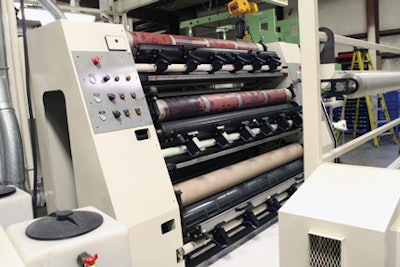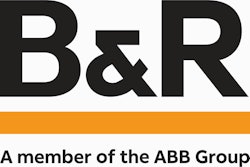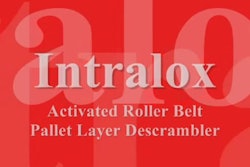Popcorn packed in microwavable bags for in-home consumption is more popular than ever. But without high-speed equipment capable of making those bags efficiently, the price points set by popcorn marketers would be so much higher that it’s unlikely the category would be experiencing its current popularity.
Which brings us to RG Engineering. This Virginia Beach builder of custom converting machinery is putting the finishing touches on a coating and laminating system that applies patches of metallized polyester to a paper substrate and then laminates a second paper substrate on top. The system also handles printing and rewinding. The material that emerges is fed into popcorn bag-making machines by the companies that buy from RG Engineering. Why the metallized polyester patches? Because that’s what causes the corn kernels to pop in the microwave oven.
RG calls its new system the MicroPop 80. Stretching 120 feet and capable of running an 80-inch wide lamination at speeds to 1,000 feet/min, its multiple converting operations (see drawing below) are performed by no less than 63 B&R servo motors and their complementary drives. The motions of all 63 are neatly synchronized over Ethernet Powerlink, a communications protocol that guarantees transfer of time-critical data within very short and precise isochronous cycles with configurable timing. It also synchronizes networked nodes with high precision in the microsecond range.
Also from B&R are six PLCs, one of which runs Windows XP. “That’s the one,” says Isaac Brown of Integrated Motion, the firm that assisted RG Engineering in the controls implementation, “that stores all the various running parameters and coordinates them with the other five. Ethernet Powerlink is what links together all the PLCs so that information on one controller can be shared with another controller. The whole idea is to keep print stations in register with the patching stations where the metallized polyester is laid down on the paper. With Powerlink connecting the two activities, we can have the patchers read the position of the print station just as if they were on the same controller.”
RG Engineering vice president David Ellingsworth says the new controls system was adopted in response to marketplace demand.
Size dictated machine design
“As the machines our customers were ordering got progressively larger and more complex, we knew we needed a new servo control system,” says Ellingsworth. “To accomplish all the coordination, synchronization, and registration we were being asked to deliver, we needed a very stable format. We also needed scalability. With the controls system we were using, we kept bumping into limitations.
“Our previous approach was to have servo controllers spread out across the system. We also had as many as five different programming languages involved. In addition to Microsoft Scripts, there was one for HMI, one for ladder logic, one for the patching systems, and a fifth for some of the drivers we were using. We’d notice that as I/O was scanned and updated, a ‘ghost’ would occasionally get scanned in. In other words, somewhere in the process a noise would get picked up, or maybe one of the processors would send something out when it wasn’t its time to do so. So everything had to be redundant. That slowed down the I/O count, because you had a separate set of software that did nothing but make sure everything was really working the way it was supposed to.
“Powerlink is much more stable. No more ghosts. And we use one common programming language to synchronize the entire machine. Until it was clear that this controls capability would be in hand, we told the customer who was asking us to develop this system that we couldn’t move forward. Without this controls system, we would have turned the project down.”
Registration is crucial
Within the 120-ft –long system are the following: two unwind stations, five patching stations, a coating/laminating station, a drier, a 6-color press, a drying station, vision inspection, and turret rewind.
“Servo-based as the machine is, you can size the foil patch and size the bag so much more easily than if the machine had a gear train,” says Integrated Motion’s Brown. “The B&R motion control is very precise and reacts quickly so that the timing of patchers, knives, and roll-fed material can all be synchronized.”
“Keeping materials in register is crucial,” says David Ellingsworth. “Powerlink is what makes it possible. For example, a vision system looks through the paper and reads the patch position relative to the print. It reports that information over Powerlink to the B&R PLC that’s running the patchers. That PLC can then advance or retard the motions it controls to keep the patch in its optimal position. The controls keep a long and complex series of actions from drifting out of register.”
Ellingsworth says the firm’s first exposure to B&R technology was in 2006 when they were building a four-color press. A pretty basic unwind/print/rewind process, this installation gave the firm a chance to see how the B&R controls package would react to high acceleration or deceleration while controlling the shaftless unwind with two drives that had to torque share.
“Among the things we like is that we can write software in a variety of programming languages,” says Ellingsworth. “I was able to choose from five different languages. You can write the entire application in simple ladder logic or you can write it in another one of their basic type languages. We selected ‘C’, partly because most college kids graduating know C or a version of C. So from a controls standpoint, this made things easy. The portions of C that you use are almost as easy as simple if/thens.”
Ellingsworth says that the limitations inherent in RG Engineering’s previous controls package prevented the company from building a coating and laminating line capable of anything faster than 600 ft/min. Not only does the new Micropop 80 run at 1,000 ft/min, the controls package provides Ellingsworth and his fellow engineers valuable visibility into the system even after it’s been installed at a customer plant.
“Every piece of data on the system is collected over Powerlink,” says Ellingsworth. “The temperature of a motor, the performance of a drive, anything on the entire line. Then it can be exported through Windows XP. So it provides the flexibility to actually talk to the plant where the machine is running. And I don’t have to involve the plant’s IT people. That’s important, because they have their own programmers, and I don’t have any control over that. I’m free to communicate directly with the controllers on the Micropop 80.”
Modularity, says Ellingsworth, is a hot button at RG Engineering, and the new controls system gets good marks on that front, too.
“A key priority for RG Engineering,” says Ellingsworth, “is that each individual section of a machine be flexible enough that the customer can break it up into different components and send them anywhere in the world to be integrated into something different, at any time. Take the auto splicing unwind, for example. You can unbolt it and ship it to another plant for operation ahead of a press. We don’t build equipment and then assume our customers are going to use it the same way without ever making a change. Five years after a sale there’s no telling what a customer might need to do differently. It’s important that all our machines be able to change and adapt and grow.”
Speaking of growth, Ellingsworth says the next system on the RG Engineering drawing board is a popcorn bag-making machine. And the controls? “We’re staying with B&R,” says Ellingsworth.






























